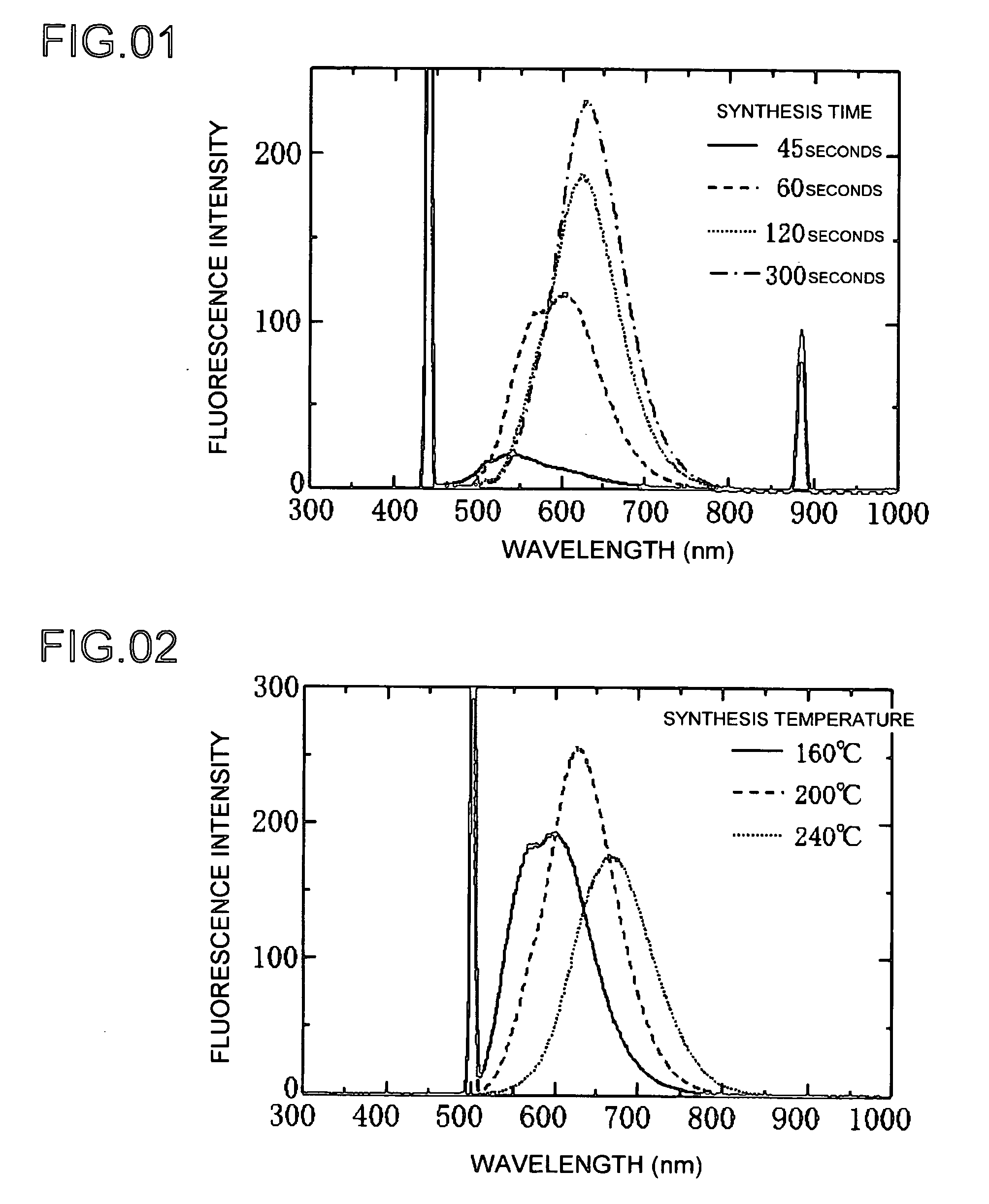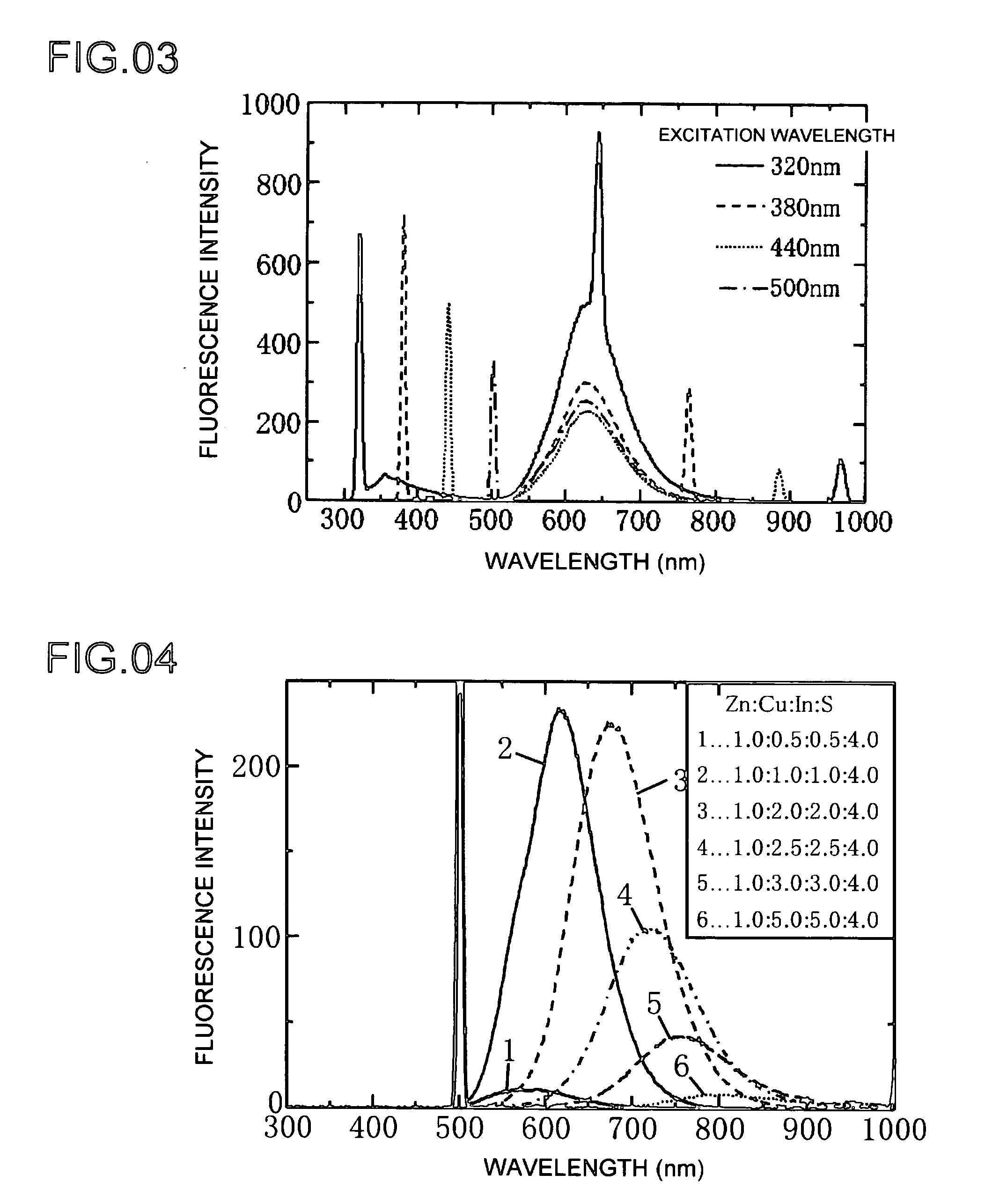Phosphor And Production Process Of Same
a production process and technology of phosphor, applied in the direction of luminescent compositions, semiconductor devices, chemistry apparatus and processes, etc., can solve the problems of difficult deployment of these semiconductors in a wide range of industrial applications, considerable environmental risks, etc., and achieve low toxicity and low toxicity
- Summary
- Abstract
- Description
- Claims
- Application Information
AI Technical Summary
Benefits of technology
Problems solved by technology
Method used
Image
Examples
example 1
[0045]The following indicates an Example 1 of producing a phosphor of the present invention. Preparation of the reaction solutions used in this research was entirely carried out in an argon atmosphere using argon gas. Copper (I) iodide and indium (III) iodide were respectively dissolved in a complexing agent in the form of oleyl amine followed by mixing using octadecene as a solvent to obtain Solution A. Zinc diethyldithiocarbaminate was dissolved in trioctylphosphine followed by mixing with octadecene to obtain Solution C. Solutions A and C were then mixed and heated for a predetermined amount of time at 160 to 280° C. The resulting product was diluted with toluene followed by measurement of absorption and fluorescence spectra. The measurement results were then graphed.
[0046]The graph of FIG. 1 shows the results of forming a phosphor at a plurality of synthesis times. FIG. 1 shows the spectra of light waves emitted by the formed phosphor versus intensity. Each graph shows the case ...
example 2
[0055]Next, Example 2 shows a different example of the production of a phosphor of the present invention. Example 2 is basically the same as Example 1, and differences between the two are described below. The composite ratio of the phosphor raw materials as Zn:Cu:In:S is 1.0:0.8:0.8:4.0. The results of measuring the characteristics of the formed phosphor were graphed. The optical absorbance of the phosphor for each of the plots in FIG. 8 is shown in the graph of FIG. 9. The graph of FIG. 8 shows the fluorescence intensity emitted by the formed phosphor as a result of heat-treating at predetermined temperatures of 160, 200 and 240° C. The heating time is 5 minutes.
[0056]Fluorescence intensity is plotted on the horizontal axis of the graph of FIG. 8, while wavelength is plotted on the horizontal axis. The quantum yields of the phosphor formed by heat-treating for 5 minutes at predetermined temperatures of 160, 200 and 240° C. were 6, 4 and 6%, respectively. Quantum yield refers to the...
example 3
[0057]Example 3 shows an example of producing a phosphor of the present invention. The production process of Example 3 is basically the same as the previously described Examples 1 and 2, and the differences there between are described below. Copper (I) iodide and indium (III) iodide were respectively dissolved in a complexing agent in the form of dodecyl amine followed by mixing using octadecene as a solvent to obtain Solution A. The concentration of copper (Cu) at this time was 0.1 mmol, that of indium (In) was 0.1 mmol, the amount of dodecyl amine was 2 ml, and the amount of octadecene was 5 ml.
[0058]Zinc diethyldithiocarbaminate was dissolved in trioctylphosphine to obtain Solution C. The concentration of zinc (Zn) at this time was 0.13 mmol, that of sulfur (S) was 0.26 mmol, and the amount of trioctylphosphine was 7 ml. Solution A and Solution C were mixed with a mixer followed by heating for a predetermined amount of time at a temperature of 160 to 240° C. in a micro-reactor. T...
PUM
 Login to View More
Login to View More Abstract
Description
Claims
Application Information
 Login to View More
Login to View More - R&D
- Intellectual Property
- Life Sciences
- Materials
- Tech Scout
- Unparalleled Data Quality
- Higher Quality Content
- 60% Fewer Hallucinations
Browse by: Latest US Patents, China's latest patents, Technical Efficacy Thesaurus, Application Domain, Technology Topic, Popular Technical Reports.
© 2025 PatSnap. All rights reserved.Legal|Privacy policy|Modern Slavery Act Transparency Statement|Sitemap|About US| Contact US: help@patsnap.com



